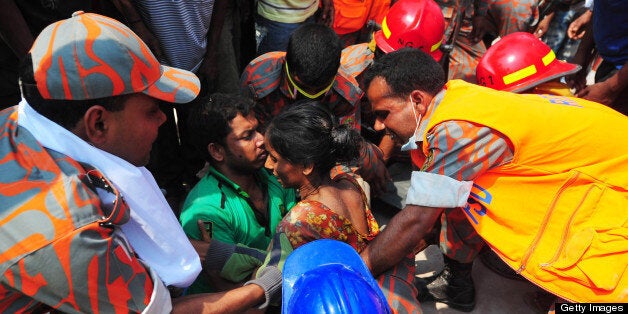
Protesters calling for the death of a building owner in Bangladesh whose eight-story structure collapsed on Wednesday, killing at least 290 people, were answered Thursday by police clubs. At least 25 garment workers were injured when police interrupted an emotional memorial procession with batons, just 200 yards from the scene where the building crumbled.
Journalists on the scene told HuffPost that anger among workers continued to rise with the death toll on Thursday. Thirty-three hours after the building fell, officials announced Thursday afternoon that they would devote another two days to rescue efforts before beginning the task of removing the building wreckage.
Fire Brigade and Civil Defence’s Director General Ali Ahmed Khan said responders had rescued 2,000 of the roughly 3,000 workers who were inside the building when it came down, but Bangladeshi media reports have put that number as high as 5,000.
"The chance of finding survivors is reducing fast as the clock ticks away. Eight out of [every] ten pulled out appear dead," Selim Ahmed, a local journalist, told The Huffington Post from the scene.
Discontent brewed quickly among workers as it became apparent the government hadn't apprehended the owners of the building or the five garment factories inside. The building, called Rana Plaza, also housed a bank and commercial shops. Many workers in the garment manufacturing industry make clothing for American consumers in unsafe conditions. Workers have said they were forced to show up for work on Wednesday, even though severe cracks had been found in the building's structure the day before.
"I fear an outburst of workers' anger at any moment. The way the home minister and the prime minister are talking about the incident is making them even angrier," a local reporter told The HuffPost. He asked that his name not be used due to his criticism of government officials.
Journalists predicted that the situation would deteriorate even further if police wait or decline to arrest the building owner, Mohammad Sohel Rana, a local ruling-party politician. Rana was last seen at the site on Wednesday, before he was escorted from the area by party sympathizers amid a public fury, local journalists on the scene told The Huffington Post.
On Tuesday, Rana said in a television interview with Etv, a Bangladeshi TV channel, that cracks that had developed in the building were only minor, and he declined to secure the building. If the death toll continues to rise, the collapse may become the worst factory disaster in recent memory in Bangladesh.
In a sign of how politicized the tragedy has become, Home minister MK Alamgir, also a ruling party politician, insinuated that the opposition party was somehow involved in the disaster.
"The fundamentalist BNP [Bangladesh Nationalist Party] had called the shutdown. I was told some hired supporters went there and shook the gates … and the pillars," Alamgir said on BBC Bangla Wednesday. "This might be the reason behind the collapse ... When part of a building caves in, it affects the whole. This might have happened.”
He maintained his theory on Thursday.
BNP is the major opposition party in Bangladesh, and it was leading a 36-hour, countrywide strike to shutdown general business when the building collapsed. It is typical in Bangladesh for politicians to claim their opponents were somehow involved in unfortunate developments, even massive disasters like the building collapse Wednesday. Online activists condemned the minister's comment, noting that a probe hadn't even been conducted yet.
"Rescue first, punishment later," said Prime Minister Sheikh Hasina.
The prime minister also blasted those who criticized the government for its cumbersome rescue efforts. “Assist in the salvage operation," she urged such detractors. "Engage yourself in the operation and then you can see why it takes time.”
Meanwhile, a large crack has appeared in another six-story building, also owned by Rana, less than a kilometer away from his collapsed building in Savar.
Journalist Selim Ahmed told HuffPost that the crack is "very large" and tenants inside had already begun to clear out their offices.